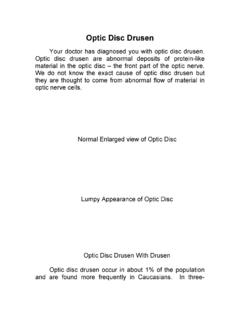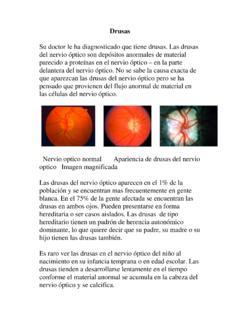Transcription of Positional Testing of Horizontal Semicircular Canal ...
1 Positional Testing of Horizontal Semicircular Canal Variant of BPPV Vestibular Skills Transfer Session 41st NANOS Meeting San Diego Kevin Kerber, MD and Luis Mejico, MD Horizontal Canal (HC) BPPV ranges from 5-20% of BPPV cases. The diagnosis of HC-BPPV can be more challenging than posterior Canal BPPV because: 1) it may be difficult to determine the affected side, 2) there are 2 forms (geotropic and apogeotropic), 3) there are several different treatment maneuvers to choose from, and 4) a central lesion may mimic this (whereas it would be much less likely for a central lesion to mimic the key features of posterior Canal BPPV). Both the test and the treatment for HC-BPPV are different than PC. -Diagnostic Maneuvers: 1. From the sitting position, have the patient lie back into supine position (this is different than Dix- Hallpike because the patient just goes straight back [no head turn] and the patient stops at supine [not head extended back like Dix-Hallpike].
2 Most patients with HC BPPV will have Horizontal nystagmus in this supine position. Note the direction as this become important later. 2. McClure-Pagnini maneuver: FROM THE SUPINE POSITION, Turn the patient s head to one side (either side). Does the nystagmus beat TOWARD the direction of the head turn (referred to as geotropic b/c from this position it is beating toward the ground), or in the direction OPPOSITE the head turn (called apogeotropic). NOW HERE IS A KEY PART, if this is HC BPPV then when you turn the head to the other side, the direction of nystagmus will switch. Example A: If there is leftbeat nystagmus on left head turn, then there should be rightbeat nystagmus after right head turn (this is called the geotropic variant). Example B: If there is rightbeat nystagmus on left head turn, then there should be leftbeat nystagmus on right head turn (this is called apogeotropic).
3 3. Once you determine the direction of the nystagmus in step 1 and whether it is geotropic or apogeotropic, THEN YOU CAN NOW figure out the side affected. If there is leftbeat nystagmus on supine Testing , then the affected side is the RIGHT side if the nystagmus follows geotropic pattern, BUT it is LEFT side if it follows apogeotropic pattern. Often you can also determine the affected by observing the difference in the velocity of nystagmus after one head turn compared with the other. With geotropic nystagmus, the affected side is typically the side that leads to the highest velocity nystagmus. The opposite is the case for apogeotropic nystagmus: the affected side is typically OPPOSITE the side that triggers the highest velocity nystagmus. 4. Basically apogeotropic means the particles are further in the Canal and generally requires 2 different maneuvers. The first maneuver is used to convert it to geotropic by moving the particles along the Canal .
4 5. Pseudospontaneous Horizontal nystagmus of low intensity may be seen while in the sitting position. In patients with the geotropic form, the direction of the fast phase is towards the healthy side with the apogeotropic form towards the affected side. This nystagmus increases by bending the head 30 backward, stops with the head bent 30 forward, and reverses direction if the head is further bent forward to 60 (Bow and Lean test). -Treatment Maneuvers: - GEOTROPIC variant: 1. Proceed with Gufoni maneuver for Geotropic (note there are a couple variations on the Gufoni maneuver). Have patient sit on side of the bed. Then quickly have patient lie down on the UNAFFECTED SIDE. Stay in that position for 2 minutes. Then have the patient quickly turn the head DOWN into the bed. Stay in that position for 1 minute. Then come up quickly. 2. Give the patient 5-10 minutes, then you can retest if you want.
5 Go Supine, then Supine head turns. IF THE NYSTAGMUS IS NOW APOGEOPTROPIC, THEN you picked the wrong side to treat!! 3. ALTERATIVE TREATMENT: For geotropic another effective treatment is to just have the patient lie on the unaffected side for 6 hours or so. This is called the Forced Prolonged Position. - APOGEOTROPIC variant: 1. Proceed with variation of the Gufoni maneuver ( Gufoni look up , because second step is to look up, rather than down). Have patient sit on side of bed. Then quickly have the patient lie down on the AFFECTED side. Stay there for 2 minutes, then quickly have the patient look up (still in side lying position). Hold 1 minute. The come up quickly. 2. Give patient 5-10 minutes, then you need to retest, because remember the goal here was just to convert apogeotropic to geotropic. If you converted it to geotropic then you now need to treat the geotropic.
6 Diagnostic maneuver: Supine Positional Test or McClure-Pagnini maneuver Particles Movement with Supine Positional Testing : Summary of diagnostic maneuvers: Characteristics of Nystagmus Apogeotropic Geotropic Head Position Prone: -neutral towards unaffected ear towards affected ear (bow& -30 back increases baseline nyst. increases baseline nyst. lean) -30 forward stops nystagmus stops nystagmus -60 forward towards affected ear towards unaffected ear Supine towards affected ear towards unaffected ear McClure-Pagnini increases to unaffected side increases to affected side Treatment maneuvers: -Gufoni maneuver for right sided geotropic HC BPPV: -Gufoni maneuver for Left sided apogeotropic HC BPPV: Recommended Reading: Fife TD, Iverson DJ, Lempert T, Furman JM, Baloh RW, Tusa RJ, Hain TC, Herdman S, Morrow MJ, Gronseth GS; Quality Standards Subcommittee, American Academy of Neurology.
7 Practice parameter: therapies for benign paroxysmal Positional vertigo (an evidence-based review): report of the Quality Standards Subcommittee of the American Academy of Neurology. Neurology. 2008 May 27;70(22):2067-74. doi: PMID: 18505980 Kim JS, Oh SY, Lee SH, Kang JH, Kim DU, Jeong SH, Choi KD, Moon IS, Kim BK, Kim HJ. Randomized clinical trial for GEOTROPIC Horizontal Canal benign paroxysmal Positional 2012 Aug 14;79(7):700-7. doi: PMID:22855868 Kim JS, Oh SY, Lee SH, Kang JH, Kim DU, Jeong SH, Choi KD, Moon IS, Kim BK, Oh HJ, Kim HJ. Randomized clinical trial for APOGEOTROPIC Horizontal Canal benign paroxysmal Positional vertigo. Neurology. 2012 Jan 17;78(3):159-66. doi: PMID: 22170885









